[vc_row][vc_column][vc_column_text]As you may already know, the OET exam is being updated in September 2018.
This article will look at the four OET test areas and will explain the upcoming exam changes.
It is important that if you are taking the test on or after September you are completely aware of the upcoming changes.
Let’s get started.[/vc_column_text][vc_row_inner][vc_column_inner][vc_column_text]
The Four Test Areas
[/vc_column_text][/vc_column_inner][/vc_row_inner][/vc_column][/vc_row][vc_row][vc_column width=”1/4″][vc_single_image image=”6595″ img_size=”full” alignment=”center”][vc_column_text]
Listening
[/vc_column_text][/vc_column][vc_column width=”1/4″][vc_single_image image=”6594″ img_size=”full” alignment=”center”][vc_column_text]
Reading
[/vc_column_text][/vc_column][vc_column width=”1/4″][vc_single_image image=”6592″ img_size=”full” alignment=”center”][vc_column_text]
Writing
[/vc_column_text][/vc_column][vc_column width=”1/4″][vc_single_image image=”6593″ img_size=”full” alignment=”center”][vc_column_text]
Speaking
[/vc_column_text][/vc_column][/vc_row][vc_row][vc_column][vc_column_text]
Part 1
The Listening Exam

The listening exam is possibly the test with the most changes overall.
The first change is that there will be less Australian accents. We have received a lot of feedback from students that the Australian accents can be difficult to understand.
Now the updated test will include more British accents which we believe will make this part of the test a little bit easier.
Many students enrolled on our online courses report finding the new recordings to be slower and easier to follow.
What are the other changes in OET listening?
The other changes are related to exam structure.
You may remember that Part A previously focused on note taking. This involved listening to the recording and making a list of words under a heading.
Now however, the questions in Part A will be fill-in-the-blank type questions. This will likely make it easier for students and it leaves less room for guessing. Simply listen to the recording and fill in the correct information.
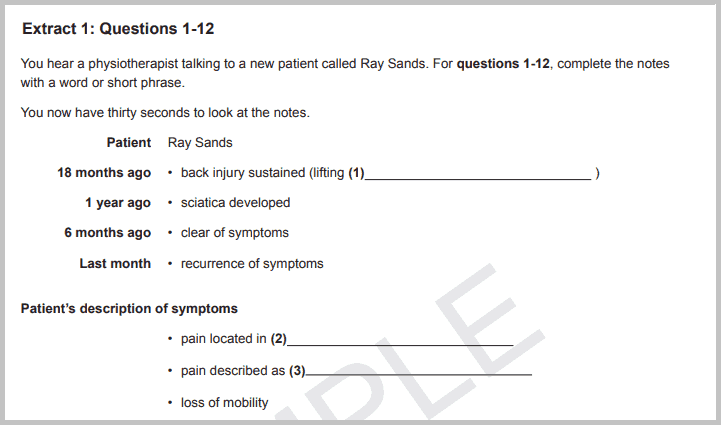
What are Parts B and C?
This is where things become a little more complex.
Part B is a completely new section that has never been seen before in the OET exam.
It will involve hearing a workplace scenario (maybe two colleagues discussion a patient, maybe a manager speaking to his staff, maybe a nurse dealing with an irate patient) and answering multiple choice questions depending on what you hear.
There will always be three options to choose from.
You can see an example of the introduction to this type of question below.
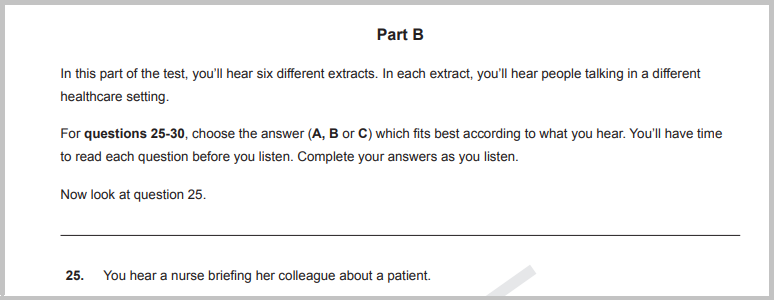
Likewise, Part C is also a new test area (although it is very similar to Part B from the old exam).
Part C involves listening two short presentations from a health professional and answering multiple choice questions. Once again, there will be three options to choose from.
This once again, appears to make the listening test a little bit easier.
In OET 1.0, there were a variety of question types, however now it will ALWAYS be multiple choice and there will ALWAYS be only three answers to choose from.
Let us know in the comments if this sounds easier or more difficult.
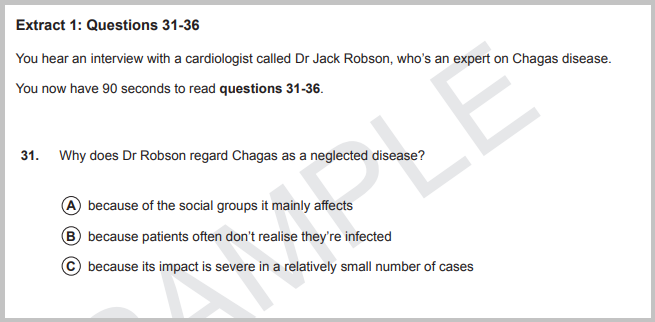
Part 2
The Reading Exam
Likewise, there are also major changes to the OET reading exam.
This is a big one.
The first change is that the test will be split into three sections (just like the listening exam): A, B and C.
Part A will still be a fast test in which you will be expected to find all of the answers within 15 minutes. The test will still assess your ability to skim and scan through texts.
A fantastic piece of news is that the new Part A of the reading exam will be guaranteed to have 20 questions every time! In the past you would have to deal with 25 or even 29 questions.
More time means more marks!
There will however be a bigger variety of question types. Take a look at the example below:
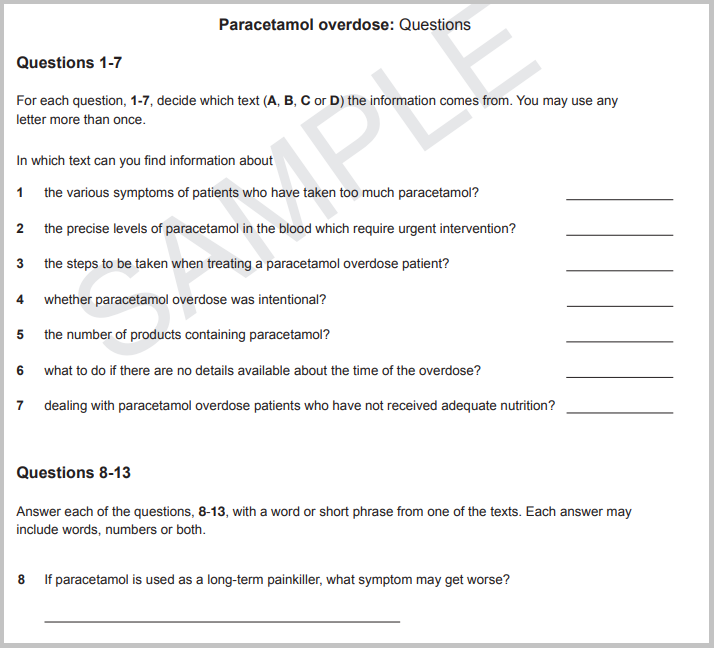
You may notice:
- A new question type in which you have to decide which text the information is included in (A, B, C, or D).
- Short answer question types.
- No more summary completion questions.
What about Parts B and C?
Part B of the reading exam will also be different. Both Parts B and the new Part C will be in a separate question paper booklet to Part A.
Part B questions will focus on a work-place scenario. (Similar to the listening exam!)
You will read a short passage of text and answer one multiple choice question per passage. You can see an example of one below:
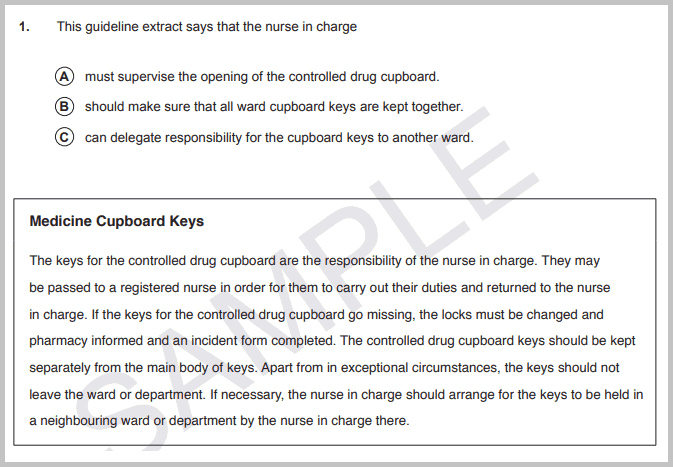
Finally, the new Part C will be very similar to the old reading Part C. However the good news is….
There will be fewer questions to answer in each passage.
You will answer eight four-option multiple choice questions. The passages will be very similar to those in the old-style test.
Part 3
The Writing Exam

Let’s keep this one short and to the point …
… the writing exam is not changing.
You can relax. All of that studying and revision you have done has not been wasted!
The writing test will be marked and graded in exactly the same way as it was in OET 1.0.
Part 4
The Speaking Exam
More good news…
The OET speaking test is also barely changing.
See for yourself. Here is a description of the test in OET 2.0 as per the Official OET website:
The Speaking sub-test … takes around 20 minutes. This part of OET uses materials specifically designed for your profession. In each role-play, you take your professional role (for example, as a nurse or as a pharmacist) while the interlocutor plays a patient, a client, or a patient’s relative or carer.
Sound familiar?
Therefore, the format of the test will be exactly the same however the examiner will now be looking for the following in your answer:
- How well you build a relationship with the patient.
- Whether you have understood the patient’s perspective.
- Is your answer structured and easy to follow?
- How well do you gather information from the patient?
- Do you take time to find out what the patient already knows?
Overall, the test is very similar. Furthermore, a good speaker should already have tried to include this information in her or her answer.
Part 5
What Is Your Opinion?
What do you think of the above changes? Did you find this article informative?
We’d love to hear from you.
Do you think the test is easier or more difficult? Do you need support with OET 2.0? Do you feel the studying you have done so far will be useful?
Leave a comment below and our teachers will get back to you with a response.[/vc_column_text][/vc_column][/vc_row]

